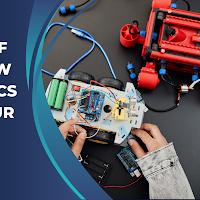
|
| The Future of Robotics: How AI and Robotics Will Shape Our World |
Table of Contents
As technology progresses at an unprecedented pace, artificial intelligence (AI) and robotics are at the forefront of shaping our world. These revolutionary fields are transforming industries, redefining human interaction, and paving the way for innovations that were once confined to science fiction. Here, we explore the profound ways AI and robotics are influencing our present and how they will continue to reshape our future.
The Integration of AI and Robotics in Daily Life
Revolutionising Healthcare with Robotics and AI
AI-powered robots are revolutionising healthcare, improving accuracy, efficiency, and patient outcomes. Robots assist in minimally invasive surgeries, where precision is paramount, while AI algorithms enhance diagnostics by analysing complex medical data to detect diseases early. For instance, AI-driven imaging systems can identify tumours in their nascent stages, ensuring timely treatment. Furthermore, robotic exoskeletons are aiding individuals with mobility challenges, offering them a new lease on life.
Transforming Transportation Systems
The emergence of autonomous vehicles is a prime example of how AI and robotics are reshaping transportation. Self-driving cars, powered by advanced machine learning algorithms, promise safer roads, reduced traffic congestion, and lower emissions. Additionally, drones are revolutionising logistics and delivery systems, ensuring faster and more efficient services.
Industrial Applications of Robotics and AI
Automation in Manufacturing
Manufacturing has embraced robotics to optimise efficiency and productivity. Robotic arms, equipped with AI capabilities, streamline assembly lines, reduce human error, and enhance quality control. These systems adapt to various tasks, making them indispensable in industries ranging from automotive to electronics.
Agricultural Innovations
AI and robotics are transforming agriculture into a high-tech industry. Autonomous tractors, drones for crop monitoring, and AI-driven predictive analytics enable farmers to maximise yields while minimising resource use. These advancements are crucial for addressing the challenges of feeding a growing global population sustainably.
The Impact on Employment and Workforce Dynamics
Emerging Job Roles
While AI and robotics automate repetitive tasks, they also create opportunities for new, highly specialised job roles. Fields such as robotics engineering, AI development, and data analysis are witnessing unprecedented growth. This transition necessitates reskilling and upskilling to align the workforce with technological advancements.
Collaboration Between Humans and Robots
The future workforce will see increased collaboration between humans and robots. Cobots, or collaborative robots, are designed to work alongside humans, enhancing productivity without replacing human ingenuity. This synergy between man and machine promises to unlock new potentials across industries.
Ethical and Societal Considerations
Ensuring Ethical AI Development
As AI systems become more integrated into decision-making processes, ensuring ethical considerations in their development is paramount. Developers must address biases, privacy concerns, and the potential misuse of AI technologies to maintain public trust and prevent societal harm.
Addressing Socioeconomic Disparities
The widespread adoption of AI and robotics could exacerbate socioeconomic disparities if not managed responsibly. Policymakers and industry leaders must ensure equitable access to these technologies to foster inclusive growth and societal harmony.
The Role of AI and Robotics in Sustainability
Reducing Environmental Impact
AI-driven solutions are critical in tackling climate change. Smart energy grids, waste management systems, and AI-powered simulations are enabling us to optimise resources and reduce environmental impact. Robotics also plays a role in environmental conservation, such as deploying underwater robots for coral reef monitoring and restoration.
Innovations in Renewable Energy
Robots equipped with AI are enhancing the efficiency of renewable energy systems. From solar panel maintenance to wind turbine inspections, these technologies are making renewable energy more reliable and cost-effective.
The Future of AI and Robotics in Education and Learning
Personalised Learning Experiences
AI is revolutionising education by offering personalised learning experiences. Adaptive learning platforms analyse student performance and tailor educational content to suit individual needs, ensuring more effective knowledge acquisition.
Robotics in STEM Education
Robotics is inspiring the next generation of innovators by making STEM (Science, Technology, Engineering, and Mathematics) education interactive and engaging. Educational robots help students develop problem-solving skills and spark curiosity in technological fields.
FAQs About AI and Robotics
1. How will AI and robotics impact future jobs?
AI and robotics will automate repetitive tasks but simultaneously create new job roles in technology, healthcare, and engineering. Reskilling will be essential to adapt to these changes.
2. Are robots replacing humans in industries?
Robots are augmenting human capabilities rather than replacing them entirely. Collaborative robots are designed to work alongside humans, enhancing productivity.
3. What are the ethical concerns surrounding AI?
Key concerns include bias in AI algorithms, data privacy issues, and the potential for misuse. Ethical AI development is crucial to address these challenges.
4. How are robots helping in healthcare?
Robots assist in surgeries, rehabilitation, and diagnostics. For example, robotic surgical systems provide precision, while exoskeletons aid mobility for patients with physical disabilities.
5. Can AI help combat climate change?
Yes, AI-driven solutions optimise resource use, enhance renewable energy systems, and provide predictive analytics for effective environmental management.
6. What role do robotics play in education?
Robotics makes STEM education interactive and encourages problem-solving and creativity, preparing students for future technological advancements.
The integration of AI and robotics is redefining the way we live, work, and interact with our environment. These transformative technologies hold the promise of a smarter, more sustainable, and inclusive future. However, as we embrace these advancements, it is imperative to navigate the challenges they pose with foresight and responsibility. Together, we can unlock the full potential of AI and robotics, shaping a world that benefits humanity at large.

